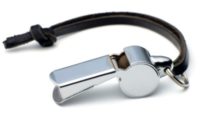 This commentary and analysis was written by Garrett Brown, former Cal/OSHA staffer for the Inside Cal/OSHA website and is reprinted here with his permission.
This commentary and analysis was written by Garrett Brown, former Cal/OSHA staffer for the Inside Cal/OSHA website and is reprinted here with his permission.
Cal/OSHA Chief Ellen Widess was instructed to attend a meeting at 11 am on September3, 2013 – the day after Labor Day – with California Labor Secretary Marty Morgenstern and Department of Industrial Relations Director Christine Baker at DIR’s Oakland Headquarters. Art Carter, chair of the Occupational Safety and Health Appeals Board and a longtime Jerry Brown confidante and political operative, was also in the room.
By 11:02 am Widess was told to resign as Chief, or be fired, to prepare a resignation statement within an hour, and to clean out her desk at Cal/OSHA by the end of the day. No explanation was given for the forced resignation, except Morgenstern and Baker said they wanted to take Cal/OSHA “in a new direction.”
Within hours of the official announcement of Widess’ resignation, the Cal/OSHA Reporter issued a “Flash Report” titled “Widess Out at Cal/OSHA – Community Cheering.” The weekly trade newsletter reported employer representatives were“ practically jubilant at the news.”
One anonymous “highly placed representative of the employer community” told the Reporter “she’s [Widess] broken so many valuable ties with the business community, it had become a problem. As an appointee of the Governor, the business community is key.”
In fact, Widess had good relations with many business leaders – but not with the California Chamber of Commerce, which had been running a full-scale campaign against Widess since early 2013. Marti Fisher, the Chamber’s chief lobbyist and likely the anonymous employer rep quoted by the Reporter, had been complaining to DIR Director Baker with rising urgency almost since Widess became Chief in April 2011. The pressure campaign went into over-drive in 2013.
By May 2013, DIR Director Baker had ordered Widess to meet with her and Fisher every fourth Wednesday of the month. The Chamber was the only stakeholder organization to be given this kind of intimate, face-to-face time to air their complaints and demands on a monthly basis with the Director of DIR and the Chief of Cal/OSHA. Widess had two of these meetings (a third was cancelled by Baker and Widess was on vacation in August)before she was forced to resign in early September.
The Chamber, on behalf of its employer members, complained they did not have access to Widess and that she would not “partner” with employers in health and safety projects. This is not true. I know because, as Widess’ Special Assistant, I helped prepare her for the regular meetings she had with employers in many economic sectors, including construction and agriculture. I was also assigned to work on several large partnership projects with manufacturing employers to prevent deaths in confined spaces, and with ag and construction employers to prevent illness and fatalities from heat exposure. Widess responded to virtually every invitation she received to speak to business organizations throughout the state.
But while employers had access to Widess as Cal/OSHA’s Chief, they did not have the kind of decisive influence they enjoyed under Widess’ predecessor, Arnold Schwarzenegger-appointee Len Welsh, who pretty much granted employers whatever they wanted.
For example, Widess rescinded an official letter Welsh had written in 2010 for Grimmway Farms allowing the grower – over the objections of Cal/OSHA’s Senior Safety Engineers – to build and use jerry-rigged caged trailers with seats to transport farmworkers from one work location to another.
Widess showed no interest in pursuing partnerships with employers like San Diego shipbuilder NAASCO (General Dynamics) whose official partnership with Cal/OSHA was cancelled in 2011 after the employer was issued “Willful” citations for refusing to stop passing massive ship sections by crane over the heads of workers below. Fed OSHA pulled out of the tri-partite partnership in 2010 because of the imminent hazards in the shipyard.
Or the partnership-in-progress (never consummated despite 7 different drafts of a partnership agreement) with the giant construction consortium KFM, which was ultimately issued “Willful” citations by Cal/OSHA’s Oakland office in 2006 for “cooking the books” of their injury records through an intense, carefully-managed campaign to discourage workers from reporting injuries through cash payments and reprisals at the San Francisco Bay Bridge’s eastern span replacement.
The Cal/OSHA Reporter Flash Report also claimed – again based on unnamed sources –that Widess was “widely unpopular” in the state’s labor community, which was also reported to be happy she was gone. But this was categorically denied by the health and safety coordinators of the California Labor Federation and the California Building &Construction Trades Council. Leaders of several unions expressed alarm and concern that Widess’ pro-worker protection policies would now be reversed as part of Cal/OSHA’s “new direction.” (see documents posted on the “Inside Cal/OSHA” website).
These concerns were and are well founded.
It is a little known fact that Cal/OSHA does not control its funding, or its budget, or its hiring or, ultimately, its policies and procedures – the Department of Industrial Relations controls all of that.
Governor Jerry Brown, a corporate Democrat whose motto is “austerity today, austerity tomorrow, austerity forever,” appointed Christine Baker as DIR Director. Baker has, and no doubt believes, the standard Republican approach to workplace health and safety enforcement.
This approach, explained by Baker in internal meetings that I personally attended or received reports about, is that the vast majority of employers either do the right thing, or would do the right thing if they knew how. So Cal/OSHA’s priority should be compliance assistance, partnerships and consultation for these responsible employers.
For the small layer of “low road” or “bad actor” employers, regulatory enforcement is required to eliminate “unfair competition” and establish a “level playing field” for “highroad” employers. But with these responsible employers making a good-faith effort and who make an honest mistake, Cal/OSHA should not be bothering them with “gotta-cha” citations and fines.
So DIR’s Labor Enforcement Task Force (LETF) will conduct enforcement actions against the “underground economy” employers, but large, politically-connected “responsible” employers will get kid-glove treatment. This is DIR’s famous “new paradigm” for Cal/OSHA, the “new direction” whose implementation required that Widess be dismissed.
A telling example of Baker’s corporate-friendly orientation was the program of DIR’s“40th anniversary of Cal/OSHA” event that was to be held in December 2013, but abruptly cancelled without explanation several weeks before the date. The four-hour, afternoon program was personally designed by Baker. The final program – I was one of the two Cal/OSHA reps on the 10-person DIR planning committee – had more employer representatives than labor representatives speaking at the event. Marti Fisher of the Chamber of Commerce – an organization that vehemently opposed the creation of OSHA and has opposed virtually every worker protection since then – was scheduled to speak not once but twice during DIR’s Cal/OSHA anniversary event.
With the forced resignation of Ellen Widess, Director Baker now has absolute and uncontested control of Cal/OSHA, its resources and policies. All three of the legally mandated leadership posts – Chief, Deputy Chief for Enforcement, and Deputy Chief for Health – are now vacant. Baker has appointed an Acting Chief, an Acting DC Enforcement (actually three people sharing the Acting role), and the DC Health position is empty. The key DC Enforcement position has had temporary assignments since June2012.
Baker’s control is being solidified as the Cal/OSHA Headquarters staff during Widess’ tenure – all longtime Cal/OSHA employees and experienced occupational health and safety professionals – are being reassigned, or replaced as they retire or leave, by DIR personnel with little or no OHS professional qualifications, or experience in regulatory enforcement, but with unconditional loyalty to the DIR Director.
Last September, also within hours of the official announcement of Widess’ resignation, well-known management attorney Fred Walter posted a blog with a laundry list of changes the most scorched-earth section of the employer community wanted implemented as part of the “new direction.” Walter ended his list of a dozen changes with the promise: “That’s for starters. Then we can talk about more structural changes.”[link to http://www.caloshablog.com/2013/09/04/calosha-chief-ellen-widess-resigns/ ]Taking stock of the new regime eight months later, in May of this year, Walter gave Director Baker and her Acting Chief of Cal/OSHA, Juliann Sum, an enthusiastic “two thumbs up” for their stewardship of Cal/OSHA. [link tohttp://www.caloshablog.com/2014/05/14/twenty-years-of-dilapidation/ ]As in all political coups, there are victims in the change of regimes. At Cal/OSHA, the victims are California’s working people whose health and safety protections on the job are being undermined and weakened in pursuit of the “new paradigm” of employer friendly compliance assistance and partnerships over strong, across-the-board regulatoryenforcement.


